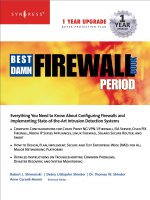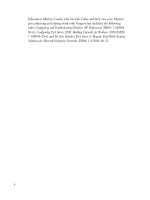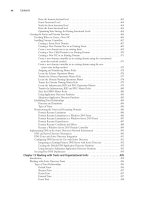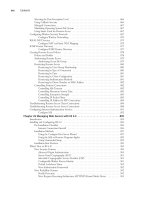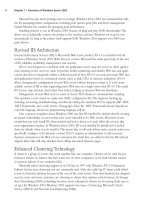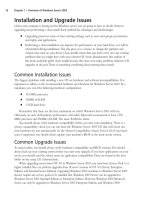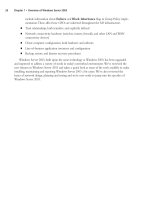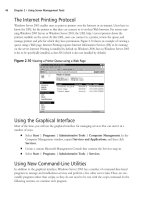the best damn firewall book period phần 1 pot
Bạn đang xem bản rút gọn của tài liệu. Xem và tải ngay bản đầy đủ của tài liệu tại đây (2.84 MB, 133 trang )
With more than 1,500,000 copies of our MCSE, MCSD, CompTIA, and Cisco
study guides in print, we continue to look for ways we can better serve the
information needs of our readers. One way we do that is by listening.
Readers like yourself have been telling us they want an Internet-based ser-
vice that would extend and enhance the value of our books. Based on
reader feedback and our own strategic plan, we have created a Web site
that we hope will exceed your expectations.
is an interactive treasure trove of useful infor-
mation focusing on our book topics and related technologies. The site
offers the following features:
■
One-year warranty against content obsolescence due to vendor
product upgrades. You can access online updates for any affected
chapters.
■
“Ask the Author” customer query forms that enable you to post
questions to our authors and editors.
■
Exclusive monthly mailings in which our experts provide answers to
reader queries and clear explanations of complex material.
■
Regularly updated links to sites specially selected by our editors for
readers desiring additional reliable information on key topics.
Best of all, the book you’re now holding is your key to this amazing site.
Just go to www.syngress.com/solutions, and keep this book handy when
you register to verify your purchase.
Thank you for giving us the opportunity to serve your needs. And be sure
to let us know if there’s anything else we can do to help you get the
maximum value from your investment. We’re listening.
www.syngress.com/solutions
252_BDFW_FM.qxd 9/19/03 4:51 PM Page i
about itfaqnet.com
Syngress Publishing is a proud sponsor of itfaqnet.com, one of the web’s
most comprehensive FAQ sites for IT professionals. This is a free service
that allows users to query over 10,000 FAQs pertaining to Cisco net-
working, Microsoft networking. Network security tools, .NET development,
Wireless technology, IP Telephony, Storage Area Networking, Java develop-
ment and much more. The content on itfaqnet.com is all derived from our
hundreds of market proven books, written and reviewed by content
experts.
So bookmark ITFAQnet.com as your first stop for mission critical advice
from the industry’s leading experts.
www.itfaqnet.com
252_BDFW_FM.qxd 9/19/03 4:51 PM Page ii
Dr. Thomas W. Shinder | Cherie Amon | Robert J. Shimonski | Debra Littlejohn Shinder
BEST
DAMN
FIREWALL
PERIOD
PERIOD
BOOK
BOOK
Anne Carasik-Henmi, Technical Editor
252_BDFW_FM.qxd 9/19/03 4:51 PM Page iii
Syngress Publishing, Inc., the author(s), and any person or firm involved in the writing, editing, or
production (collectively “Makers”) of this book (“the Work”) do not guarantee or warrant the results to be
obtained from the Work.
There is no guarantee of any kind, expressed or implied, regarding the Work or its contents.The Work is
sold AS IS and WITHOUT WARRANTY. You may have other legal rights, which vary from state to state.
In no event will Makers be liable to you for damages, including any loss of profits, lost savings, or other
incidental or consequential damages arising out from the Work or its contents. Because some states do not
allow the exclusion or limitation of liability for consequential or incidental damages, the above limitation
may not apply to you.
You should always use reasonable care, including backup and other appropriate precautions, when working
with computers, networks, data, and files.
Syngress Media®, Syngress®,“Career Advancement Through Skill Enhancement®,”“Ask the Author
UPDATE®,” and “Hack Proofing®” are registered trademarks of Syngress Publishing, Inc. “Syngress:The
Definition of a Serious Security Library™,”“Mission Critical™,” and “The Only Way to Stop a Hacker is to
Think Like One™” are trademarks of Syngress Publishing, Inc. Brands and product names mentioned in this
book are trademarks or service marks of their respective companies.
KEY SERIAL NUMBER
001 PK9ST3V343
002 KATHYT6CVF
003 8J9HFJASQN
004 Z2B4NDREAY
005 U8J3N5R33S
006 X6B7MATTY6
007 G8TR2SH2AK
008 9BKTHQM4S7
009 SW4KP7V6FH
010 5BVF7UM39Z
PUBLISHED BY
Syngress Publishing, Inc.
800 Hingham Street
Rockland, MA 02370
The Best Damn Firewall Book Period
Copyright © 2003 by Syngress Publishing, Inc. All rights reserved. Printed in the United States of America.
Except as permitted under the Copyright Act of 1976, no part of this publication may be reproduced or
distributed in any form or by any means, or stored in a database or retrieval system, without the prior
written permission of the publisher, with the exception that the program listings may be entered, stored,
and executed in a computer system, but they may not be reproduced for publication.
Printed in the United States of America
1 2 3 4 5 6 7 8 9 0
ISBN: 1-931836-90-6
Technical Editor: Anne Carasik-Henmi Cover Designer: Michael Kavish
Acquisitions Editor: Catherine B. Nolan Page Layout and Art by: Patricia Lupien & John Vickers
Indexer: J. Edmund Rush Copy Editor: Beth A. Roberts & Amy Thomson
Distributed by Publishers Group West in the United States and Jaguar Book Group in Canada.
252_BDFW_FM.qxd 9/19/03 4:51 PM Page iv
v
Anne Carasik-Henmi is a System Administrator at the Center for Advanced
Computational Research (CACR) at the California Institute of Technology. She is
in charge of information security at CACR, which includes every aspect of infor-
mation security including intrusion detection (running Snort, of course), network
security, system security, internal IT auditing, and network security policy. Her
specialties include Linux, Secure Shell, public key technologies, penetration
testing, and network security architectures. Anne’s background includes positions
as a Principal Security Consultant at SSH Communications Security, and as an
Information Security Analyst at VeriSign, Inc.
Debra Littlejohn Shinder (MCSE) is a technology consultant, trainer, and
writer who has authored a number of books on networking, including: Scene of
the Cybercrime: Computer Forensics Handbook published by Syngress Publishing
(ISBN: 1-931836-65-5), and Computer Networking Essentials, published by Cisco
Press. She is co-author, with her husband Dr.Thomas Shinder, of Troubleshooting
Windows 2000 TCP/IP (ISBN: 1-928994-11-3), the best-selling Configuring ISA
Server 2000 (ISBN: 1-928994-29-6), and ISA Server and Beyond (ISBN: 1-931836-
66-3). Deb is also a technical editor and contributor to books on subjects such as
the Windows 2000 MCSE exams, the CompTIA Security+ exam, and
TruSecure’s ICSA certification. She edits the Brainbuzz A+ Hardware News and
Sunbelt Software’s WinXP News and is regularly published in TechRepublic’s
TechProGuild and Windowsecurity.com. Deb specializes in security issues and
Microsoft products. She lives and works in the Dallas-Fort Worth area and can be
contacted at or via the website at
www.shinder.net.
Thomas W. Shinder M.D. (MVP, MCSE) is a computing industry veteran
who has worked as a trainer, writer, and a consultant for Fortune 500 companies
including FINA Oil, Lucent Technologies, and Sealand Container Corporation.
Tom was a Series Editor of the Syngress/Osborne Series of Windows 2000
Certification Study Guides and is author of the best selling books Configuring ISA
Server 2000: Building Firewalls with Windows 2000 (Syngress Publishing, ISBN: 1-
928994-29-6) and Dr.Tom Shinder’s ISA Server and Beyond (ISBN: 1-931836-66-
3).Tom is the editor of the Brainbuzz.com Win2k News newsletter and is a
regular contributor to TechProGuild. He is also content editor, contributor, and
moderator for the World’s leading site on ISA Server 2000, www.isaserver.org.
Microsoft recognized Tom’s leadership in the ISA Server community and awarded
him their Most Valued Professional (MVP) award in December of 2001.
Contributor andTechnical Editor
Contributors
252_BDFW_FM.qxd 9/19/03 4:51 PM Page v
vi
Robert J. Shimonski (TruSecure TICSA, Cisco CCDP, CCNP, Symantec SPS,
NAI Sniffer SCP, Nortel NNCSS, Microsoft MCSE, MCP+I, Novell Master
CNE, CIP, CIBS, CNS, IWA CWP, DCSE, Prosoft MCIW, SANS.org GSEC,
GCIH, CompTIA Server+, Network+, Inet+, A+, e-Biz+, Security+, HTI+) is a
Lead Network and Security Engineer for a leading manufacturing company,
Danaher Corporation. At Danaher, Robert is responsible for leading the IT
department within his division into implementing new technologies, standardiza-
tion, upgrades, migrations, high-end project planning and designing infrastructure
architecture. Robert is also part of the corporate security team responsible for set-
ting guidelines and policy for the entire corporation worldwide. In his role as a
Lead Network Engineer, Robert has designed, migrated, and implemented very
large-scale Cisco and Nortel based networks. Robert has held positions as a
Network Architect for Cendant Information Technology and worked on accounts
ranging from the IRS to AVIS Rent a Car, and was part of the team that rebuilt
the entire Avis worldwide network infrastructure to include the Core and all
remote locations. Robert maintains a role as a part time technical trainer at a local
computer school, teaching classes on networking and systems administration
whenever possible.
Robert is also a part-time author who has worked on over 25 book projects
as both an author and technical editor. He has written and edited books on a
plethora of topics with a strong emphasis on network security. Robert has
designed and worked on several projects dealing with cutting edge technologies
for Syngress Publishing, including the only book dedicated to the Sniffer Pro pro-
tocol analyzer. Robert has worked on the following Syngress Publishing titles:
Building DMZs for Enterprise Networks (ISBN: 1-931836-88-4), Security+ Study
Guide & DVD Training System (ISBN: 1-931836-72-8), Sniffer Pro Network
Optimization & Troubleshooting Handbook (ISBN: 1-931836-57-4), Configuring and
Troubleshooting Windows XP Professional (ISBN: 1-928994-80-6),SSCP Study Guide
& DVD Training System (ISBN: 1-931836-80-9), Nokia Network Security Solutions
Handbook (ISBN: 1-931836-70-1) and the MCSE Implementing and Administering
Security in a Windows 2000 Network Study Guide & DVD Training System (ISBN: 1-
931836-84-1).
Robert’s specialties include network infrastructure design with the Cisco
product line, systems engineering with Windows 2000/2003 Server, NetWare 6,
Red Hat Linux and Apple OSX. Robert’s true love is network security design
and management utilizing products from the Nokia, Cisco, and Check Point
arsenal. Robert is also an advocate of Network Management and loves to ‘sniff ’
networks with Sniffer-based technologies. When not doing something with com-
puter related technology, Robert enjoys spending time with Erika, or snow-
boarding wherever the snow may fall and stick.
252_BDFW_FM.qxd 9/19/03 4:51 PM Page vi
vii
Cherie Amon (CCSA, CCSE, CCSI, NSA) is technical editor of and contrib-
utor to the best selling Check Point Next Generation Security Administration
(Syngress Publishing, ISBN: 1-928994-74-1), as well as the Nokia Network Security
Solutions Handbook (Syngress, ISBN: 1-931836-70-1). Cherie is a Senior
Professional Security Engineer at Integralis, a systems integrator specializing in IT
and e-commerce security solutions. She is both a Check Point and Nokia
Certified Security Instructor and has been installing, configuring, and supporting
Check Point products since 1997. Cherie currently provides third-tier technical
support to Integralis clients and acts as Technical Lead for many managed firewall
accounts. Cherie is a member of USENIX and SAGE.
Kyle X. Hourihan (NSA) is the Course Development Manager and a Senior
Technical Trainer for Nokia Internet Communications in Mountain View, CA.
He designs, writes, and teaches Nokia Internet Division’s internal and external
training material. He conducts Train-the-Trainer sessions for Nokia Authorized
Training Partners as well as high-end training for Nokia’s internal R&D and
TACs (Telephone Assistance Centers). Kyle has been working in Network
Security since 1999, and previously worked for 3Com as a Senior Instructor and
Developer for their Carrier Systems Division (Commworks). He began his career
working as a programmer writing code for Cisco IOS implementing minor
routing protocols and performing software QA on their routers. Kyle earned a
bachelor’s of Science in Computer Science from the University of Maryland,
College Park. He was a co-author of the highly acclaimed Nokia Network Security
Solutions Handbook (Syngress Publishing, ISBN: 1-931836-70-1), and he is also a
co-author of Freesoft.org (www.freesoft.org), a comprehensive source of Internet
engineering information. Kyle resides in Palo Alto, CA.
James Stanger (Ph.D., Symantec Technology Architect (STA), Convergence
Technology Professional, CIW Master Administrator, MCP, Linux+,A+) is co-
author of Syngress Publishing’s E-mail Virus Protection Handbook (ISBN: 1-928994-
23-7) and Hack Proofing Linux: A Guide to Open Source Security (ISBN:
1-928994-34-2). A network security consultant and writer, James’ specialties
include virus management, mail server administration, intrusion detection, and
network auditing. Currently Senior Course Director for ProsoftTraining, James
consults with Symantec to enable security professionals to deploy virus protec-
tion, vulnerability management, and firewall/VPN solutions in enterprise net-
works. James has also consulted for companies and organizations such as IBM,
Securify, Brigham Young University, ITM Technology, and the William Blake
Archive. James is the Chairperson of the Linux Professional Institute (LPI)
Advisory Council and sits on the CompTIA Linux+ and Server+ cornerstone
committees. In addition to authoring books for Syngress, James has also authored
security books and courses for Sybex, Osborne/McGraw-Hill, and
ComputerPREP. James resides in Washington.
252_BDFW_FM.qxd 9/19/03 4:51 PM Page vii
viii
Randy Cook (SCSA) is a Senior Engineer with BayMountain (www.baymoun-
tain.com) a local IT services company. Randy was the co-author and technical
editor of the Sun Certified System Administrator for Solaris 8.0 Study Guide (ISBN:
0-07-212369-9), and Syngress Publishing’s Hack Proofing Sun Solaris 8.0 (ISBN: 1-
928994-34-2) and has written technical articles for industry publications. He has
also hosted a syndicated radio program, Technically News, which provided news
and information for IT professionals.
252_BDFW_FM.qxd 9/19/03 4:51 PM Page viii
Contents
ix
Foreword xxxiii
Part I Introduction to Network Security & Firewalls 1
Chapter 1 Introduction to Information Security 3
Introduction 4
Insecurity and the Internet 4
Defining Information Security 6
Common Information Security Concepts 8
Knowledge Is Power 8
Think Like a Thief 9
Removing Intrusion Opportunities 9
Threats and Attacks 10
Physical Security 10
Network Security 11
Recognizing Network Security Threats 12
Understanding Intruder Motivations 13
Recreational Hackers 13
Profit-Motivated Hackers 13
Vengeful Hackers 14
Hybrid Hackers 15
Categorizing Security Solutions 15
Back to Basics:TCP/UDP Well-Known Ports 15
IP Half-Scan Attack 16
Source-Routing Attack 17
Other Protocol Exploits 17
System and Software Exploits 17
Trojans, Viruses, and Worms 18
Classifying Specific Types of Attacks 20
Social Engineering Attacks 20
Protecting Your Network Against Social Engineers 21
Denial-of-Service Attacks 22
Scanning and Spoofing 28
Security Policies 31
Preventing Intentional Internal Security Breaches 31
Tactical Planning 31
Designating Responsibility for Network Security 32
Responsibility for Developing the Security Plan and Policies 32
Responsibility for Implementing and Enforcing the Security Plan and Policies 32
Designing the Corporate Security Policy 33
Developing an Effective Password Policy 33
Designing a Comprehensive Security Plan 36
Evaluating Security Needs 38
252_BDFW_TOC.qxd 9/19/03 6:38 PM Page ix
x Contents
Assessing the Type of Business 38
Assessing the Type of Data 38
Assessing the Network Connections 39
Assessing Management Philosophy 39
Understanding Security Ratings 40
Legal Considerations 41
Addressing Security Objectives 41
Know Your Users 41
Control Your Users 41
Hiring and Human Resource Policies 42
Creating a Security Policy 42
Educating Network Users on Security Issues 42
Protecting Information Technology 45
Improving Security 45
Protecting the Servers 46
Keeping Workstations Secure 46
Protecting Network Devices 46
Using SSL and Secure Shell 47
Testing Security 47
Other Hardware Security Devices 49
Monitoring Activity 49
Detecting Internal Breaches 50
Preventing Unauthorized External Intrusions and Attacks 50
Summary 52
Chapter 2 Firewall Concepts 53
Introduction 54
Defining a Firewall 54
Types of Firewalls 55
Packet Filters 56
Stateful Inspection Packet Filters 56
Application Proxies 57
Networking and Firewalls 58
Firewall Interfaces: Inside, Outside, and DMZ 58
Firewall Policies 61
Address Translation 62
Static Translation 63
Dynamic Translation 63
Port Address Translation 64
Virtual Private Networking 64
Popular Firewalls 66
Hardware-Based Firewalls 67
The Cisco PIX Firewall 68
Nokia Firewall 69
Firewall Software 69
Check Point FW-1 69
Darren Reed’s IPFilter 70
Microsoft ISA Server 70
Summary 71
Chapter 3 DMZ Concepts, Layout, and Conceptual Design 73
Introduction 74
DMZ Basics 74
DMZ Concepts 78
252_BDFW_TOC.qxd 9/19/03 6:38 PM Page x
Contents xi
Traffic Flow Concepts 84
Networks with and without DMZs 88
Pros and Cons of DMZ Basic Designs 89
DMZ Design Fundamentals 90
Why Design Is So Important 90
Putting It All Together: A Business Case Study 91
Designing End-to-End Security for Data Transmission between Hosts on the Network 92
Traffic Flow and Protocol Fundamentals 93
DMZ Protocols 93
Designing for Protection in Relation to the Inherent Flaws of TCP/IPv4 94
Public and Private IP Addressing 94
Ports 95
Using Firewalls to Protect Network Resources 96
Using Screened Subnets to Protect Network Resources 97
Securing Public Access to a Screened Subnet 97
Traffic and Security Risks 98
Application Servers in the DMZ 99
Domain Controllers in the DMZ 99
RADIUS-Based Authentication Servers in the DMZ 100
VPN DMZ Design Concepts 100
Advanced Risks 101
Business Partner Connections 101
Extranets 102
Web and FTP Sites 102
E-Commerce Services 102
E-Mail Services 103
Advanced Design Strategies 103
Advanced DMZ Design Concepts 103
Remote Administration Concepts 104
Authentication Design 106
DMZ High Availability and Failover 106
DMZ Server Cluster 106
The PIX Failover Services 107
What Causes Failover to Occur 109
Summary 110
Chapter 4 Introduction to Intrusion Detection Systems 111
Introduction 112
What Is Intrusion Detection? 112
Network IDS 114
Host-Based IDS 115
Distributed IDS 115
What Is an Intrusion? 117
Why Are Intrusion Detection Systems Important? 118
Why Are Attackers Interested in Me? 118
Where Does an IDS Fit with the Rest of My Security Plan? 119
Doesn’t My Firewall Serve as an IDS? 119
Where Else Should I Be Looking for Intrusions? 120
Backdoors and Trojans 121
What Else Can Be Done with Intrusion Detection? 122
Monitoring Database Access 122
Monitoring DNS Functions 123
252_BDFW_TOC.qxd 9/19/03 6:38 PM Page xi
xii Contents
E-Mail Server Protection 123
Using an IDS to Monitor My Company Policy 123
Summary 124
PartII Solaris & Linux Firewalls 125
Chapter 5 Implementing a Firewall with Ipchains and Iptables 127
Introduction 128
Understanding the Need for a Firewall 129
Building a Personal Firewall 130
Understanding Packet Filtering Terminology 130
Choosing a Linux Firewall Machine 131
Protecting the Firewall 131
Deploying IP Forwarding and Masquerading 132
Masquerading 134
Configuring Your Firewall to Filter Network Packets 136
Customized Packet Filtering 137
Configuring the Kernel 137
Packet Accounting 137
Understanding Tables and Chains in a Linux Firewall 138
Built-In Targets and User-Defined Chains 139
Specifying Interfaces 139
Setting Policies 140
Using Ipchains to Masquerade Connections 143
Iptables Masquerading Modules 143
Using Iptables to Masquerade Connections 144
Iptables Modules 145
Exercise: Masquerading Connections Using Ipchains or Iptables 145
Logging Packets at the Firewall 146
Setting Log Limits 146
Adding and Removing Packet Filtering Rules 147
ICMP Types 147
Exercise: Creating a Personal Firewall and Creating a User-Defined Chain 149
Redirecting Ports in Ipchains and Iptables 151
Configuring a Firewall 151
Setting a Proper Foundation 152
Creating Anti-Spoofing Rules 152
Counting Bandwidth Usage 155
Listing and Resetting Counters 156
Setting Type of Service (ToS) in a Linux Router 156
Setting ToS Values in Ipchains and Iptables 157
Using and Obtaining Automated Firewall Scripts and Graphical Firewall Utilities 159
Weighing the Benefits of a Graphical Firewall Utility 160
Firewall Works in Progress 160
Exercise: Using Firestarter to Create a Personal Firewall 161
Exercise: Using Advanced Firestarter Features 167
Summary 169
Chapter 6 Maintaining Open Source Firewalls 171
Introduction 172
Testing Firewalls 172
IP Spoofing 173
Open Ports/Daemons 173
Monitoring System Hard Drives, RAM, and Processors 174
Suspicious Users, Logins, and Login Times 174
Check the Rules Database 175
252_BDFW_TOC.qxd 9/19/03 6:38 PM Page xii
Contents xiii
Verify Connectivity with Company Management and End Users 175
Port Scans 176
Using Telnet, Ipchains, Netcat, and SendIP to Probe Your Firewall 176
Ipchains 177
Telnet 177
Using Multiple Terminals 178
Netcat 178
Sample Netcat Commands 179
Additional Netcat Commands 180
Using Netcat 181
SendIP:The Packet Forger 182
SendIP Syntax 182
Using SendIP to Probe a Firewall 184
Understanding Firewall Logging, Blocking, and Alert Options 185
Firewall Log Daemon 186
Obtaining firelogd 186
Syntax and Configuration Options 186
Message Format 187
Customizing Messages 188
Reading Log Files Generated by Other Firewalls 189
Configuring and Compiling firelogd 190
fwlogwatch 191
fwlogwatch Modes 191
fwlogwatch Options and Generating Reports 192
Generating an HTML-Based Firewall Log with fwlogwatch 195
Automating fwlogwatch 195
The fwlogwatch Configuration File 196
Notification Options 197
Response Options 199
Configuring fwlogwatch to Send Automatic Alerts and Block Users 201
Using fwlogwatch with CGI Scripts 202
Obtaining More Information 203
Viewing the Results 204
Using cron and fwlogwatch CGI Scripts to Generate an Automatic HTML Report 205
Additional fwlogwatch Features 207
Obtaining Additional Firewall Logging Tools 207
Summary 209
Chapter 7 Configuring Solaris as a Secure Router and Firewall 211
Introduction 212
Configuring Solaris as a Secure Router 212
Reasoning and Rationale 212
Routing Conditions 213
The S30network.sh Script 214
The S69inet Script 214
Configuring for Routing 215
A Seven-Point Checklist 216
Security Optimization 218
Security Implications 219
Minimal Installation 219
Minimal Services 219
Minimal Users 220
Minimal Dynamic Information 220
Minimal Cleartext Communication 220
252_BDFW_TOC.qxd 9/19/03 6:38 PM Page xiii
xiv Contents
Unconfiguring Solaris Routing 220
A Three-Point Checklist 221
Routing IP Version 6 222
Configuration Files 222
The hostname6.interface File 222
The ndpd.conf File 223
The ipnodes File 224
The nsswitch.conf File 225
IPv6 Programs 225
The in.ndpd Program 225
The in.ripngd Program 226
The ifconfig Command 227
IPv6 Router Procedure 227
Stopping IPv6 Routing 228
Method 1: Rebooting the System 228
Method 2: Not Rebooting the System 228
IP Version 6 Hosts 229
Automatic Configuration 229
Manual Configuration 230
The ipnodes File 230
DNS 231
Configuring Solaris as a Secure Gateway 231
Configuring Solaris as a Firewall 232
General Firewall Theory 232
General Firewall Design 233
SunScreen Lite 234
IP Filter 234
Using NAT 235
Summary 236
Part III PIX Firewalls 239
Chapter 8 Introduction to PIX Firewalls 241
Introduction 242
PIX Firewall Features 242
Embedded Operating System 242
The Adaptive Security Algorithm 243
State 244
Security Levels 246
How ASA Works 246
Technical Details for ASA 246
User Datagram Protocol 250
Advanced Protocol Handling 251
VPN Support 251
URL Filtering 252
NAT and PAT 252
High Availability 254
PIX Hardware 254
Models 254
PIX 501 254
PIX 506 256
PIX 506E 256
PIX 515 256
PIX 515E 256
252_BDFW_TOC.qxd 9/19/03 6:38 PM Page xiv
Contents xv
PIX 520 257
PIX 525 257
PIX 535 257
The Console Port 257
Software Licensing and Upgrades 259
Licensing 261
Upgrading Software 261
Password Recovery 262
The Command-Line Interface 264
Factory Default Configurations 264
PIX 501 and 506E 264
PIX 515E, 525, and 535 264
Administrative Access Modes 265
Basic Commands 267
Hostname and Domain Name 268
Configuring Interfaces 268
Static Routes 269
Password Configuration 270
Managing Configurations 271
The write Command 271
The copy Command 271
The configure Command 272
Resetting the System 273
The reload Command 273
Summary 274
Chapter 9 Passing Traffic 277
Introduction 278
Allowing Outbound Traffic 278
Configuring Dynamic Address Translation 278
Identity NAT and NAT Bypass 282
Blocking Outbound Traffic 284
Access Lists 284
Outbound/Apply 290
Allowing Inbound Traffic 292
Static Address Translation 292
Access Lists 293
Conduits 294
ICMP 295
Port Redirection 295
TurboACLs 296
Object Grouping 297
Configuring and Using Object Groups 297
ICMP-Type Object Groups 298
Network Object Groups 298
Protocol Object Groups 299
Service Object Groups 299
Case Study 301
Access Lists 302
Conduits and Outbound/Apply 305
Summary 308
Chapter 10 Advanced PIX Configurations 309
Introduction 310
252_BDFW_TOC.qxd 9/19/03 6:38 PM Page xv
xvi Contents
Handling Advanced Protocols 310
File Transfer Protocol 314
Active vs. Passive Mode 314
Domain Name Service 318
Simple Mail Transfer Protocol 320
Hypertext Transfer Protocol 321
Remote Shell 322
Remote Procedure Call 323
Real-Time Streaming Protocol, NetShow, and VDO Live 324
SQL*Net 328
H.323 and Related Applications 328
Skinny Client Control Protocol 331
Session Initiation Protocol 331
Internet Locator Service and Lightweight Directory Access Protocol 333
Filtering Web Traffic 334
Filtering URLs 334
Websense and N2H2 335
Fine-Tuning and Monitoring the Filtering Process 337
Active Code Filtering 339
Filtering Java Applets 341
Filtering ActiveX Objects 341
DHCP Functionality 341
DHCP Clients 342
DHCP Servers 343
Cisco IP Phone-Related Options 347
Other Advanced Features 347
Fragmentation Guard 347
AAA Floodguard 349
SYN Floodguard 349
The TCP Intercept Feature in PIX v5.3 and Later 350
Reverse-Path Forwarding 351
Unicast Routing 353
Static and Connected Routes 353
Routing Information Protocol 355
Stub Multicast Routing 357
SMR Configuration with Clients on a More Secure Interface 358
SMR Configuration with Clients on a Less Secure Interface 360
Access Control and Other Options 361
PPPoE 362
Summary 365
Chapter 11 Troubleshooting and Performance Monitoring 367
Introduction 368
Troubleshooting Hardware and Cabling 368
Troubleshooting PIX Hardware 370
Troubleshooting PIX Cabling 378
Troubleshooting Connectivity 381
Checking Addressing 382
Checking Routing 384
Failover Cable 388
Checking Translation 389
Checking Access 392
Troubleshooting IPsec 396
IKE 398
252_BDFW_TOC.qxd 9/19/03 6:38 PM Page xvi
Contents xvii
IPsec 401
Capturing Traffic 404
Displaying Captured Traffic 405
Display on the Console 405
Display to a Web Browser 406
Downloading Captured Traffic 406
Support Options as Troubleshooting Tools 407
Monitoring and Troubleshooting Performance 408
CPU Performance Monitoring 408
The show cpu usage Command 410
The show processes Command 410
The show perfmon Command 411
Memory Performance Monitoring 413
The show memory Command 413
The show xlate Command 413
The show conn Command 413
The show block Command 414
Network Performance Monitoring 414
The show interface Command 414
The show traffic Command 415
Identification (IDENT) Protocol and PIX Performance 415
Summary 417
Part IV Check Point NG and Nokia IP Series Appliances 419
Chapter 12 Installing and Configuring VPN-1/FireWall-1 Next Generation 421
Introduction 422
Before You Begin 422
Obtaining Licenses 423
Securing the Host 424
Disabling Services 425
Routing and Network Interfaces 426
Enabling IP Forwarding 428
Configuring DNS 428
Preparing for VPN-1/FireWall-1 NG 429
Administrators 433
GUI Clients 434
Upgrading from a Previous Version 434
Installing Check Point VPN-1/FireWall-1 NG on Windows 435
Installing from CD 435
Configuring Check Point VPN-1/FireWall-1 NG on Windows 444
Licenses 444
Administrators 446
GUI Clients 449
Certificate Authority Initialization 450
Installation Complete 452
Getting Back to Configuration 453
Uninstalling Check Point VPN-1/FireWall-1 NG on Windows 455
Uninstalling VPN-1 & FireWall-1 456
Uninstalling SVN Foundation 458
Uninstalling Management Clients 459
Installing Check Point VPN-1/FireWall-1 NG on Solaris 460
Installing from CD 460
Configuring Check Point VPN-1/FireWall-1 NG on Solaris 465
252_BDFW_TOC.qxd 9/19/03 6:38 PM Page xvii
xviii Contents
Licenses 466
Administrators 467
GUI Clients 469
SNMP Extension 470
Group Permission 471
Certificate Authority Initialization 471
Installation Complete 473
Unload defaultfilter Script 474
Getting Back to Configuration 475
Uninstalling Check Point VPN-1/FireWall-1 NG on Solaris 476
Uninstalling VPN-1 & FireWall-1 477
Uninstalling SVN Foundation 480
Uninstalling Management Clients 482
Installing Check Point VPN-1/FireWall-1 NG on Nokia 483
Installing the VPN-1/FireWall-1 NG Package 483
Upgrading IPSO Images 483
Installing VPN-1/FireWall-1 NG 484
Configuring VPN-1/FireWall-1 NG on Nokia 487
Summary 489
Chapter 13 Using the Graphical Interface 491
Introduction 492
Managing Objects 492
Network Objects 493
Workstation 494
Network 496
Domain 497
OSE Device 498
Embedded Device 499
Group 500
Logical Server 501
Address Range 502
Gateway Cluster 503
Dynamic Object 503
Services 504
TCP 505
UDP 506
RPC 506
ICMP 507
Other 508
Group 508
DCE-RPC 509
Resources 509
Uniform Resource Identifier 509
URI for QoS 510
SMTP 510
FTP 510
Open Platform for Security Applications 510
Servers 510
Radius 510
Radius Group 511
TACACS 511
Defender 511
Lightweight Database Access Protocol Account Unit 512
252_BDFW_TOC.qxd 9/19/03 6:38 PM Page xviii
Contents xix
Certificate Authority 512
SecuRemote DNS 513
Internal Users 513
Time 513
Group 514
Scheduled Event 514
Virtual Link 514
Adding Rules 515
Rules 515
Adding Rules 515
Source 516
Destination 516
Service 516
Action 516
Track 517
Install On 517
Time 518
Comment 518
Global Properties 518
FW-1 Implied Rules 518
Viewing Implied Rules 519
SYNDefender 519
Security Server 520
Authentication 520
VPN-1 520
Desktop Security 520
Visual Policy Editor 520
Gateway High Availability 521
Management High Availability 521
Stateful Inspection 521
LDAP Account Management 521
Network Address Translation 521
ConnectControl 521
Open Security Extension 521
Log and Alert 521
SecureUpdate 521
Log Viewer 524
Column Selections 525
System Status 525
Summary 527
Chapter 14 Creating a Security Policy 529
Introduction 530
Reasons for a Security Policy 530
How to Write a Security Policy 531
Security Design 533
Firewall Architecture 533
Writing the Policy 534
Introduction 535
Guidelines 535
Standards 535
Procedures 536
Deployment 537
Enforcement 537
252_BDFW_TOC.qxd 9/19/03 6:38 PM Page xix
xx Contents
Modifications or Exceptions 537
Implementing a Security Policy 537
Default and Initial Policies 537
Translating Your Policy into Rules 538
Defining a Firewall Object 540
Define Rule Base 544
Manipulating Rules 547
Cut and Paste Rules 547
Disable Rules 548
Delete Rules 548
Hiding Rules 548
Drag and Drop 549
Querying the Rule Base 549
Policy Options 549
Verify 550
Install 550
Uninstall 550
View 550
Access Lists 550
Install Users Database 551
Management High Availability 551
Installing a Security Policy 551
Policy Files 552
Summary 554
Chapter 15 Advanced Configurations 555
Introduction 556
Check Point High Availability (CPHA) 556
Enabling High Availability 556
Failing Over 559
Firewall Synchronization 560
Single Entry Point VPN Configurations (SEP) 562
Gateway Configuration 563
Policy Configuration 567
Multiple Entry Point VPN Configurations (MEP) 567
Overlapping VPN Domains 568
Gateway Configuration 571
Overlapping VPN Domains 572
Other High Availability Methods 574
Routing Failover 574
Hardware Options 575
Summary 576
Chapter 16 Configuring Virtual Private Networks 577
Introduction 578
Encryption Schemes 578
Encryption Algorithms; Symmetric versus Asymmetric Cryptography 579
Key Exchange Methods:Tunneling versus In-Place Encryption 580
Hash Functions and Digital Signatures 581
Certificates and Certificate Authorities 582
Types of VPNs 582
VPN domains 582
Configuring an FWZ VPN 582
Defining Objects 583
252_BDFW_TOC.qxd 9/19/03 6:38 PM Page xx
Contents xxi
Local Gateway 583
Remote Gateway 584
Adding VPN Rules 584
FWZ Limitations 586
Configuring an IKE VPN 586
Defining Objects 586
Local Gateway 586
Remote Gateway 587
Adding VPN Rules 588
Testing the VPN 590
Debugging VPNs 591
Considerations for External Networks 592
Configuring a SecuRemote VPN 593
Local Gateway Object 593
User Encryption Properties 594
FWZ 594
IKE 594
Client Encryption Rules 595
Installing SecuRemote Client Software 596
Using SecuRemote Client Software 598
Making Changes to Objects_5_0.C Stick 599
Secure Domain Login 600
VPN Management 600
Summary 601
Chapter 17 Overview of the Nokia Security Platform 603
Introduction 604
Introducing the Nokia IP Series Appliances 604
Enterprise Models 605
IP120 605
IP330 606
IP400 Series 607
IP530 608
IP650 609
IP700 610
Administration Made Easy 611
Summary 614
Chapter 18 Configuring the Check Point Firewall 615
Introduction 616
Preparing for the Configuration 616
Obtaining Licenses 617
Configuring Your Host Name 618
Understanding FireWall-1 Options 618
Configuring the Firewall 620
Installing the Package 620
Enabling the Package 621
Environment and Path 622
VPN-1 and FireWall-1 Directory Structure 622
IP Forwarding and Firewall Policies 623
Unload InitialPolicy Script 625
Running cpconfig 626
Licenses 628
Administrators 629
252_BDFW_TOC.qxd 9/19/03 6:38 PM Page xxi
xxii Contents
Management Clients 631
Certificate Authority Initialization 633
Installation Complete 636
Getting Back to Configuration 636
Testing the Configuration 638
Testing GUI Client Access 638
Pushing and Fetching Policy 641
FireWall-1 Command Line 645
Upgrading the Firewall 645
Upgrading from 4.1 SP6 to NG FP2 646
Upgrading from NG FP2 to NG FP3 648
Backing Out from NG to 4.1 648
Summary 650
Chapter 19 Introducing the Voyager Web Interface 651
Introduction 652
Basic System Configuration, Out of the Box 652
Front Screen 653
Navigating Voyager 653
Configuring Basic Interface Information 654
IP Addresses 654
Speed and Duplex 657
Confirming Interface Status 657
Adding a Default Gateway 659
Setting the System Time, Date, and Time Zone 660
Time and Date 660
Configuring the Network Time Protocol 661
Configuring Domain Name System and Host Entries 662
DNS 663
The Hosts Table 664
Configuring a Mail Relay 665
Configuring System Event Notification 665
Configuring the System for Security 666
Enabling SSH Access 666
SSH Versions 1 and 2 667
Host Keys 667
Authorized Keys 668
Starting the Daemon 668
Disabling Telnet Access 669
An Alternative to FTP 669
Securing FTP 670
Configuring Secure Socket Layer 671
Creating the Self-Signed Certificate 671
Enabling HTTPS for Voyager 672
Understanding Configuration Options 674
Interface Configuration 674
System Configuration 674
SNMP 675
IPv6 675
Reboot, Shut Down System 675
Security and Access Configuration 676
Fault Management Configuration 676
Routing Configuration 676
Traffic Management 677
Router Services 678
252_BDFW_TOC.qxd 9/19/03 6:38 PM Page xxii
Contents xxiii
Summary 679
Chapter 20 Basic System Administration 681
Introduction 682
Rebooting the System 682
Managing Packages 683
Installing New Packages 683
Voyager 684
The Command Line 686
Enabling and Disabling Packages 688
Removing Packages 689
Managing IPSO Images 689
Upgrading to a New IPSO 690
Installing with newimage 692
Deleting Images 693
Managing Users and Groups 694
Users 694
The admin User 694
The monitor User 695
Other Users 695
Groups 696
Configuring Static Routes 699
System Backup and Restore 700
Configuration Sets 700
Making Backups 701
Restoring Backups 704
System Logging 705
Local System Logging 706
Remote Logging 706
Audit Logs 707
Scheduling Tasks Using cron 708
Summary 710
Chapter 21 High Availability and Clustering 713
Introduction 714
Designing Your Cluster 714
Why Do You Need a Cluster? 714
Resilience 714
Increased Capacity 714
High Availability or Load Sharing? 715
Load Sharing 715
High Availability 715
Clustering and Check Point 715
Operating System Platform 715
Clustering and Stateful Inspection 715
Desire for Stickiness 716
Location of Management Station 716
A Management Station on a Cluster-Secured Network 716
Management Station on Internal Network 718
Connecting the Cluster to Your Network : Hubs or Switches? 719
FireWall-1 Features, Single Gateways versus Clusters:The Same, But Different 719
Network Address Translation 719
Security Servers 720
Remote Authentication Servers 721
252_BDFW_TOC.qxd 9/19/03 6:38 PM Page xxiii
xxiv Contents
External VPN Partner Configuration 721
Installing FireWall-1 NG FP3 721
Checking the Installation Prerequisites 721
Installation Options 722
Installation Procedure 723
Check Point ClusterXL 727
Configuring ClusterXL in HA New Mode 727
Prerequisites for Installing ClusterXL in HA New Mode 727
Configuration of ClusterXL HA New Mode 729
Testing ClusterXL in HA New Mode 743
Test 1: Pinging the Virtual IP Address of Each Interface 743
Test 2: Using SmartView Status to Examine the Status of the Cluster Members 744
Test 3: FTP Session Through the Cluster When an Interface Fails 745
Command-Line Diagnostics on ClusterXL 745
How Does ClusterXL HA New Mode Work? 748
ClusterXL HA New Mode Failover 749
ClusterXL Failover Conditions 752
Special Considerations for ClusterXL in HA New Mode 755
Network Address Translation 755
Configuring ClusterXL in HA Legacy Mode 758
Configuring ClusterXL in Load-Sharing Mode 759
Prerequisites for Configuring ClusterXL in Load-Sharing Mode 759
Configuration of ClusterXL in Load-Sharing Mode 759
Testing ClusterXL in Load-Sharing Mode 759
Test 1: Pinging the Virtual IP Address for Each Interface 759
Test 2: Using SmartView Status to Examine the Status of the Cluster Members 760
Test 3: FTPing through ClusterXL Load Sharing During Failover 760
Command-Line Diagnostics for ClusterXL 761
How ClusterXL Works in Load-Sharing Mode 764
ClusterXL Load-Sharing Mode Failover 765
Special Considerations for ClusterXL in Load-Sharing Mode 767
Network Address Translation 767
User Authentication and One-Time Passcodes 767
Nokia IPSO Clustering 768
Nokia Configuration 768
A Few Points about Installing an Initial Configuration of NG FP3 on Nokia IPSO 769
Check Point FireWall-1 Configuration for a Nokia Cluster 769
Configuring the Gateway Cluster Object 770
Nokia Cluster Configuration on Voyager 774
Voyager Configuration 774
Testing the Nokia Cluster 778
Test 1: Pinging the Virtual IP Address of Each Interface 778
Test 2: Determining the Status of Each Member in the Cluster 779
Test 3: FTPing through a Load-Sharing Nokia Cluster During Interface Failure 781
Command-Line Stats 782
How Nokia Clustering Works 784
Nokia Cluster Failover 786
Nokia Failover Conditions 787
Special Considerations for Nokia Clusters 787
Network Address Translation 787
Defining the Cluster Object Topology 788
Nokia IPSO VRRP Clusters 788
Nokia Configuration 788
252_BDFW_TOC.qxd 9/19/03 6:38 PM Page xxiv
